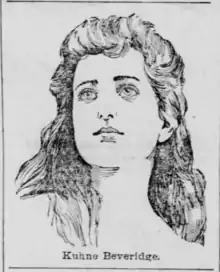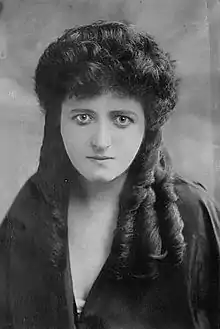

Kühne Beveridge Branson (31 October 1874 – 2 November 1944) was an American sculptor.
She was born in Springfield, Illinois, the daughter of Phis Judson Beveridge and Ella Rutzer,[1] and the granddaughter of the 16th Governor of Illinois John L. Beveridge. She studied under William R. O'Donovan in New York City, and under Rodin in Paris. Among her works are a statue called Rhodesia, Rough Rider Monument, a statue called Lascire, which belongs to Dr. Jameson, busts of Cecil Rhodes, King Edward VII, Grover Cleveland, Adlai Stevenson, Joseph Jefferson, Buffalo Bill, Bryan Mahon, Tom L. Johnson, and many others. Beveridge was first noticed as an artist in the US in 1892, when her busts of former President Cleveland and Jefferson called favorable attention to her.
In 1893, she married actor Charles Francis Coghlan, who was nearly 40 years older than her.[2] She soon discovered that he had a living common-law wife at the time of her marriage and obtained a divorce for desertion when Coghlan returned to live with the woman.[3] Before she went to South Africa, Beveridge had executed several commissions for Cecil Rhodes and others living in that region. Beveridge received an Honorable Mention in the 1900 Paris Exposition.[4] With the help of her mother, she also made a statue The Veiled Venus for the Paris Exposition,[5] which was awarded a bronze medal at the Paris Salon and was placed in Leeds Museum, England[6] She also made San Francisco weeping at the Golden Gate for the San Francisco Golden Gate Park.[7]
In 1903 in London, Beveridge married a second time to William B. Branson,[1873-1936] an American who resided at Johannesburg, in the Transvaal.[8]
In 1910, under her maiden name, she exhibited in Leipzig, Germany, a sculpture of man and woman called "The Vampire" [the exploitation of woman by man].[9] In 1913, Beveridge was a resident of Mayfair, London England[10] In 1914, her sister Ray Beveridge, an actress, was divorced from her husband Irving Seliger.[11][12] In February 1916, Beveridge was interviewed in her Munich, Germany studio.[13] In May 1916, she was still at her Munich Studio.[14] In June 1930, she was selected as a member of the Illinois Hall of Fame.[15]
During the Second World War, Beveridge resided in Nazi Germany. She died of a stroke in the spa town Bad Salzbrunn (now Szczawno-Zdrój, Poland), in 1944. She was buried in Wałbrzych.[16][17][18]
References
- ↑ San Francisco Call, Volume 96, Number 18, 18 June 1904 Ella became the Countess von Wrede and died May 8, 1904
- ↑ "Charles Coghlan's Young Wife." New York Times; October 27, 1893; pg. 2;
- ↑ "Otherwise Unnoticed." The Herald-Dispatch, Decatur, Illinois, September 15, 1894; Pg. 17
- ↑ American Art Directory, Volume 10 1913.p. 221
- ↑ Official Illustrated Catalogue, Fine Arts Exhibit, United States of America ...By U.S. Commission to the Paris Exposition, 1900
- ↑ Madera Tribune, Volume XLVI, Number 48, 26 June 1930 accessed October 15,2018
- ↑ [Granite: Published ... in the interests of the producer, manufacturer and retailer of granite as used for monumental or building purposes archive, Volume 17, 1907]
- ↑ Waters, Clara Erskine Clement (1904). Women in the Fine Arts: From the Seventh Century B.C. to the Twentieth Century A.D. (Public domain ed.). Houghton, Mifflin. pp. 43–.
- ↑ The New international year book .p.653 1910
- ↑ American Art Directory, Volume 10 1913. 221
- ↑ The day book., June 05, 1914, NOON EDITION, Image 6
- ↑ Los Angeles Herald, Volume XLVI, Number 252, 22 August 1921 Ray Beveridge remarried in Germany
- ↑ Richmond times-dispatch., February 27, 1916, Image 47
- ↑ The sun., May 21, 1916, FIFTH SECTION SPECIAL FEATURE SUPPLEMENT, Page 5, Image 55
- ↑ Madera Tribune, Volume XLVI, Number 48, 26 June 1930 accessed October 15,2018
- ↑ Eastern Prussian Provinces, Germany [Poland], Selected Civil Vitals, 1874–1945
- ↑ Reports of Deaths of American Citizens Abroad, 1835–1974
- ↑ Find a grave Kühne Beveridge Branson
Bibliography
 This article incorporates text from this source, which is in the public domain: C. E. C. Waters' "Women in the Fine Arts: From the Seventh Century B.C. to the Twentieth Century A.D." (1904)
This article incorporates text from this source, which is in the public domain: C. E. C. Waters' "Women in the Fine Arts: From the Seventh Century B.C. to the Twentieth Century A.D." (1904)